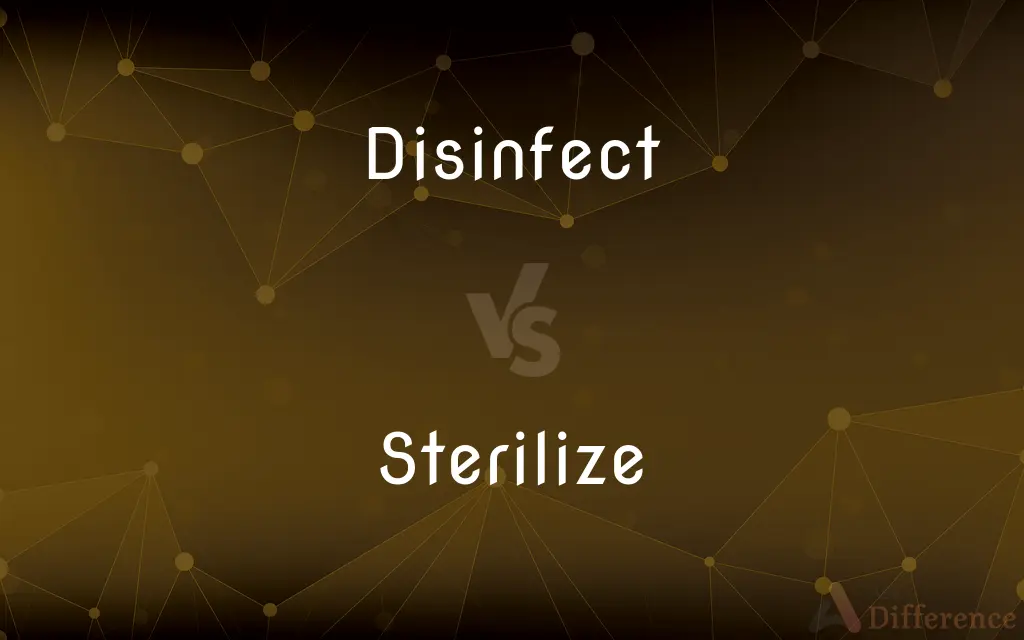Disinfect vs. Sterilize — What's the Difference?
By Tayyaba Rehman — Updated on September 22, 2023
Disinfecting kills many harmful organisms; sterilizing eliminates all living microbes. Both aim to reduce disease spread.

Difference Between Disinfect and Sterilize
Table of Contents
ADVERTISEMENT
Key Differences
Disinfecting and sterilizing are essential practices to ensure the cleanliness and safety of objects and surfaces. While they both serve the purpose of reducing or eliminating harmful microorganisms, the degree and method by which they achieve this differ significantly.
Disinfecting refers to the process of killing or inactivating a large percentage of pathogens and harmful microorganisms on a surface. This process doesn't necessarily kill all microbes but reduces them to a level deemed safe for human contact. Common disinfectants include products with ingredients like alcohol, bleach, or hydrogen peroxide. They're typically used in household cleaning and in environments like hospitals to ensure a safer environment.
On the other hand, sterilizing is a more intensive process that aims to eradicate all living microorganisms from an object or surface. This includes bacteria, viruses, fungi, and even bacterial spores, which are hardy and challenging to eliminate. Sterilization is crucial in settings like surgical rooms where absolute cleanliness is mandatory to prevent infections.
In essence, while both disinfecting and sterilizing serve to ensure cleanliness and safety, disinfecting reduces the number of pathogens to safe levels, whereas sterilizing aims to eliminate all microorganisms entirely. Thus, understanding when to apply each process is crucial based on the level of cleanliness required.
Comparison Chart
Objective
Kills many harmful organisms
Eliminates all living microbes
ADVERTISEMENT
Completeness
Partial elimination
Total elimination
Common Agents
Alcohol, bleach
Heat, radiation, chemicals
Use Cases
Household cleaning, hospitals
Surgical tools, lab equipment
Effect on Spores
May not kill bacterial spores
Kills bacterial spores
Compare with Definitions
Disinfect
To clean with a substance that kills harmful bacteria.
Make sure to disinfect the countertops after preparing raw meat.
Sterilize
Deactivate any infectious agents by various methods.
We use an autoclave to sterilize our equipment.
Disinfect
Remove pathogens from a surface.
They use ultraviolet light to disinfect the room.
Sterilize
Destroy all living microorganisms on an object.
Dental tools are sterilized after each patient's use.
Disinfect
Eliminate harmful organisms to prevent disease.
Disinfect your hands frequently during flu season.
Sterilize
Make something free from bacteria or other living microbes.
The laboratory equipment needs to be sterilized before any experiment.
Disinfect
To make a place or object free from microbes.
After the patient left, the nurse began to disinfect the examination table.
Sterilize
Make incapable of producing infection or germs.
They sterilize the water to make it safe for drinking.
Disinfect
Treat with chemicals to reduce germ presence.
Before bandaging the wound, it's crucial to disinfect it.
Sterilize
To eliminate all forms of life, especially microorganisms, from a surface or medium.
Before the surgery, they sterilize all the instruments.
Disinfect
To cleanse so as to destroy or prevent the growth of disease-carrying microorganisms
Disinfect a hospital room.
Sterilize
Make (something) free from bacteria or other living microorganisms
Babies' feeding equipment can be cleaned and sterilized
Disinfect
To sterilize by the use of cleaning agent.
Sterilize
Deprive (a person or animal) of the ability to produce offspring, typically by removing or blocking the sex organs
She fell pregnant despite having been sterilized
Disinfect
To free from infectious or contagious matter; to destroy putrefaction; to purify; to make innocuous.
When the infectious matter and the infectious matter and the odoriferous matter are one . . . then to deodorize is to disinfect.
Sterilize
To make free from live bacteria or other microorganisms.
Disinfect
Destroy microorganisms or pathogens by cleansing;
Disinfect a wound
Sterilize
To eliminate the ability of a person or animal to produce offspring, as by altering or removing the reproductive organs.
Sterilize
To make incapable of bearing fruit or germinating.
Sterilize
To render (land) unfruitful.
Sterilize
(Economics) To place (gold) in safekeeping so as not to affect the supply of money or credit.
Sterilize
To make inoffensive or innocuous
Sterilized the terminology with euphemisms.
Sterilize
(transitive) To deprive of the ability to procreate.
Sterilize
(transitive) To make unable to produce; to make unprofitable.
Sterilize
To kill, deactivate (denature), or destroy (break apart) all living, viable microorganisms and spores on a surface, in a fluid, or contained in a compound, such as culture media or a medical product.
Sterilize
(transitive) To redact (a document), removing classified or sensitive material.
Sterilize
To make sterile or unproductive; to impoverish, as land; to exhaust of fertility.
Sterilize
To deprive of the power of reproducing; to render incapable of germination or fecundation; to make sterile.
Sterilize
To destroy all spores or germs in (an organic fluid or mixture) or on (a medical instrument), as by heat, so as to prevent contamination by bacteria or other organisms. A common method of sterilization in laboratories and medical facilities is to heat a liquid sample or an instrument in an autoclave.
Sterilize
To destroy all spores or germs on (a surface) by wetting with an antiseptic liquid, such as an alcoholic solution.
Sterilize
Make free from bacteria
Sterilize
Make infertile;
In some countries, people with genetically transmissible disbilites are sterilized
Common Curiosities
How does heat sterilize objects?
High heat kills all living microorganisms, making it an effective sterilization method.
Are disinfecting and sterilizing the same?
No, disinfecting kills many harmful organisms, while sterilizing eliminates all living microbes.
Can boiling water disinfect?
Boiling can disinfect by killing many pathogens, but it's not as complete as sterilization.
Are disinfectants safe for all surfaces?
No, some disinfectants may damage certain surfaces. Always read the label.
Are all bacteria eliminated during sterilization?
Yes, sterilization aims to kill all bacteria, including spores.
Can I disinfect with soap and water?
Soap and water can clean and reduce germs, but they may not disinfect completely.
Is household bleach a disinfectant?
Yes, when properly diluted, bleach can be an effective disinfectant.
Why is it vital to sterilize surgical instruments?
To prevent infections, ensuring patient safety during procedures.
What's more rigorous, disinfecting or sterilizing?
Sterilizing is more rigorous, aiming to kill all living organisms.
Is UV light used to sterilize?
Yes, UV light can be used to sterilize surfaces by damaging microbial DNA.
Share Your Discovery

Previous Comparison
Praise vs. Thanksgiving
Next Comparison
Shine vs. BrightAuthor Spotlight
Written by
Tayyaba RehmanTayyaba Rehman is a distinguished writer, currently serving as a primary contributor to askdifference.com. As a researcher in semantics and etymology, Tayyaba's passion for the complexity of languages and their distinctions has found a perfect home on the platform. Tayyaba delves into the intricacies of language, distinguishing between commonly confused words and phrases, thereby providing clarity for readers worldwide.














































